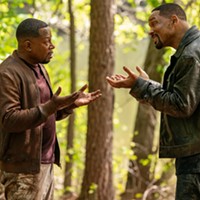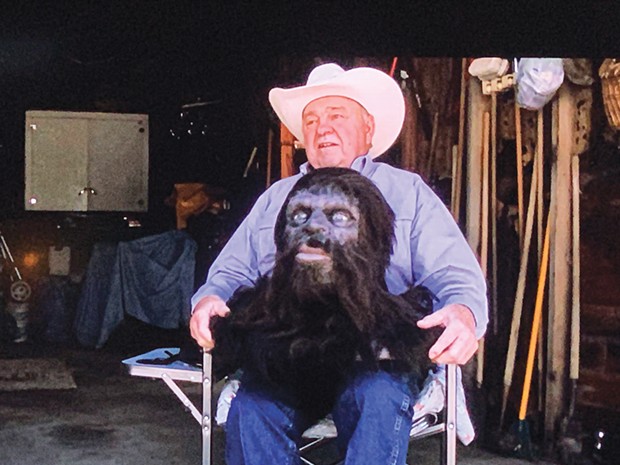Hominids and Homicide
Sasquatch goes into the woods
By Grant Scott-Goforth [email protected] @GScottGoforth[
{
"name": "Top Stories Video Pair",
"insertPoint": "7",
"component": "17087298",
"parentWrapperClass": "fdn-ads-inline-content-block",
"requiredCountToDisplay": "1"
}
]
SASQUATCH. I imagined a collective groan when trailers for Hulu's Sasquatch rolled across screens on the North Coast. Another exploitative, sensationalist "documentary" on the Emerald Triangle to make a buck off a bunch of curious outsiders, great.
That wouldn't be unfair, given the impact of Murder Mountain. We're a proud and insular bunch, not necessarily unfriendly to outsiders but certainly to the misconceptions that breed outside of the redwood curtain.
I didn't watch Murder Mountain and, unlike this column's regular writer, I have largely steered clear of the true crime/documentary boom of the streaming age. I enjoyed the podcast Serial, an honest exploration of the journalistic process, a messy, ambiguous journey fraught with uncertainty. My few other forays into the contemporary genre — Three Identical Strangers, Making a Murderer — left me incensed with their careless and borderline unethical treatment of the subjects and their stories.
But back to Sasquatch, which, for its faults, is an astute, entertaining portrait of a quirky, dangerous, insular community most North Coast viewers are familiar with. The three-part series, directed by Joshua Rofé (Lorena), begins with journalist David Holthouse recounting a nearly 30-year-old experience that haunts him.
In the fall of 1993, he was working a cannabis farm off Spy Rock Road in Northern Mendocino County. One night, sheltering from a rainstorm in the owner's A-frame cabin, two very spooked neighbors arrived, saying that Bigfoot had brutally killed some Mexican farm workers at a grow down the road. Holthouse and a friend clearly remember their visitors' fear, and the deluge of stories about the area being terrorized by Bigfoots.
Holthouse never believed Bigfoot murdered the men, but couldn't shake that memory or his curiosity.
The first episode explores the Bigfoot angle. He interviews all of the cryptozoological heavyweights: local legend James "Bobo" Fay (of Animal Planet's Finding Bigfoot), professor Jeff Meldrum, Bob Gimlin (of the Patterson-Gimlin Film fame), as well as a neighbor of Gimlin's who claims to be the man in the suit in that recognizable clip.
The true believers are canny interview subjects, though Holthouse clearly doesn't believe. They also provide the foundation for Sasquatch's biggest strength: an exploration of mythmaking, dark truths, belief and how these ancient human constructs play out in a small community's consciousness.
Holthouse himself is interesting material. A survivor of childhood sexual assault, he translated the feelings of worthlessness brought on by trauma into a fearlessness he's applied to gonzo journalism, making himself welcome among criminal enterprises, neo-Nazis and gutter punks. "Stalking monsters was a recurring thing for me," he says.
His unsettling charisma and wit make his infiltrations believable, and he spends much of the documentary driving rural backroads or holed up in a road motel, giving off Dale-Cooper-doppelganger vibes.
As the series progresses, Holthouse delves deeper into the 1990s grow scene of Spy Rock, which was rumored to be largely under Hell's Angel control, with back-to-the-landers being replaced by increasingly militarized mega-growers. This change is, of course, in conjunction with the highly militarized CAMP operations that saw heavily armed law enforcement teams raiding and razing all over the North Coast.
Sasquatch summarizes the tensions of this era well, and interviews with former CAMP members show how little has been learned from that costly, misguided approach. Holthouse and interviewees also provide a good, if brief, history of the brutality that white settlers — after gold, then timber — brought to the area, and the parallels within the cannabis industry. Tensions between white and Latinx growers becomes a central point in Holthouse's search for what happened to the three men in 1993, who were never found.
Holthouse's interviews with people from the '90s Northern Mendocino scene — including Razor, who was born into the Hell's Angels and is now in the legal industry near the Salton Sea; and Ghostdance, an idiosyncratic grower — lead him to people who heard similar tales of murder on Spy Rock.
He eventually hones in on a pair of big-timers, Bigfoot Gary and &^%#, a source who is never named. The filmmakers ratchet up the suspense, as Holthouse conducts interviews with anonymous sources in motel rooms, squalid grows and Laytonville parking lots.
In the end, Holthouse is forced to go back to his 1993 memory. Like Serial, I appreciate that Sasquatch does not shy away from the ambiguities of the search for truth. Memory is a tricky thing and a pre-internet, secretive, drug-laden community only tangles the story more.
There are missteps locals will easily spot, like the attempt to make the redwood forest an ominous character with spooky music over B-roll of misty canopies and dark, winding roads. Never mind how much of Bigfoot lore and interest focuses on more inland areas.
The pixelated faces and recreated phone calls become a bit much by the third episode, and, in one inane moment, Holthouse enters a sheriff's office with a hidden camera, then promptly asks (and receives) permission to record the detective's conversation. Why try to appear covert?
Regardless, Sasquatch's three episodes are well crafted and never feels like it's wasting your time. Sure it's sensational — it's about Bigfoot and illegal drugs in the 1990s. But it doesn't paint all of the Emerald Triangle with a broad brush. It focuses on a small area and explores how powerful mythmaking can be within and beyond its borders. TVMA. 138M. HULU.
Speaking of...
-

Music Tonight: Saturday, June 22
Jun 22, 2024 -

Quiet Movies, Big Feelings
Jun 20, 2024 -

The Importance of Bad Boys: Ride or Die
Jun 13, 2024 - More »
more from the author
-
Flamin' Hot's Stale Corporate Propaganda
- Jun 15, 2023
-
Hell is Visiting Other People
- Sep 22, 2022
-
The Bear Roars
- Aug 18, 2022
- More »

































